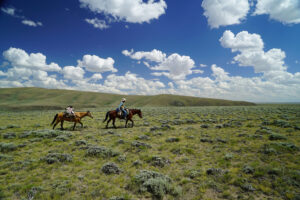QUANAH PARKER WENT FROM FIERCE ‘STONE AGE WARRIOR’ TO SPOKESMAN FOR THE COMANCHE NATION.
“HIS FACE WAS smeared with the black war paint, which gave his features a satanic look. A large, cruel mouth added to his ferocious appearance.” This was Quanah Parker. “The chief is a striking feature. He was attired in ordinary street costume and a soft black hat, his braided locks, tied in two plaits down his back, his erect bearing, his seamed and wrinkled countenance immediately disclosed to most observers his identity.” This, too, was Quanah Parker.
The two passages—Captain Robert G. Carter’s portrayal of the fierce Comanche warrior of 1871 and The Dallas Morning News‘ description of the celebrity of 1910—were about the same man. Quanah Parker, indeed, was a man of different worlds.Both lives of Quanah, who led his people during the wars on the southern Plains and then guided them through the reservation years, are competently chronicled in Bill Neeley’s biography, The Last Comanche Chief: The Life and Times of Quanah Parker (John Wiley & Sons, Inc., New York, 1995, $24.95).
Quanah, meaning “fragrant,” was born about 1850, son of Comanche Chief Peta Nocona and Cynthia Ann Parker, a white girl taken captive during the 1836 raid on Parker’s Fort, Texas. Neeley says Nocona was of the Comanche’s Quahada(sometimes spelled Kwahadi) band. Some historians have called Nocona a member of the Noconie band.
Cynthia Ann Parker was recaptured, along with a daughter, during an 1860 raid on the Pease River in northwest Texas. She had spent 24 years among the Comanche, however, and never readjusted to living with the whites again. She died in Anderson County, Texas, in 1864 shortly after the death of her daughter, Prairie Flower. Ironically, Cynthia Ann’s half-blood son would adjust remarkably well to living among the white men. But first he would lead a bloody war against them.
Quanah and the Quahada Comanche refused to accept the provisions of the 1867 Treaty of Medicine Lodge, which confined the southern Plains Indians to a reservation and promised to clothe the Indians and turn them into farmers. Quanah remained on the warpath, raiding in Texas and Mexico and outmaneuvering Army Colonel Ranald S. Mackenzie and others. But he was almost killed during the attack on buffalo hunters at Adobe Walls in the Texas Panhandle in 1874. And the Army was relentless in its Red River campaign of 1874-75; the Quahada were weary and starving.
Mackenzie sent Jacob J. Sturm, a physician and post interpreter, to solicit the Quahada’s surrender. Sturm found Quanah, whom he called “a young man of much influence with his people,” and pleaded his case. Quanah rode to a mesa, where he saw a wolf come toward him, howl and trot away to the northeast. Overhead, an eagle “glided lazily and then whipped his wings in the direction of Fort Sill.” This was a sign, Quanah thought, and on June 2, 1875, Quanah and his band surrendered at Fort Sill in present-day Oklahoma.
Neeley writes: “Not only did Quanah pass within the span of a single lifetime from a Stone Age warrior to a statesman in the age of the Industrial Revolution, but he accepted the challenge and responsibility of leading the whole Comanche tribe on the difficult road toward their new existence.”
Quanah was traveling the “white man’s road,” but he did it his way. He refused to give up polygamy, much to the reservation agents’ chagrin. He also used peyote, negotiated grazing rights with Texas cattlemen, and invested in a railroad. He learned English, became a reservation judge, lobbied Congress and pleaded the cause of the Comanche Nation. Among his friends were cattleman Charles Goodnight and President Theodore Roosevelt. He considered himself “a man who has tried to do right both to the people of his tribe and to his pale-faced friends.”
But it wasn’t easy. Mackenzie appointed Quanah as chief of the Comanche shortly after his surrender, but Neeley writes “the older chiefs still resented Quanah’s youth, and his white blood in particular.” And in 1892, when Quanah signed the Jerome Agreement that broke up the reservation, the Comanche were split into two factions: “Those who realized…that all that could be done had been done for the Indians; and those who blamed Chief Parker for selling their country.” Quanah died on Febrary 23, 1911, and was buried next to his mother, whose body he had had reinterred at Post Oak Cemetery in Oklahoma only three months earlier.
In the book’s forward, Quanah’s grandson James M. Cox gives Neeley the Comanche name of “Chatuh-bohtuh,” meaning”good writer.” Neeley, though, could have used a good editor. He gives Quanah’s adversary and conqueror, Mackenzie, the rank of general, when, in fact, the man was a colonel (although he had been breveted a general during the Civil War), says that 75,000 cattle were shipped out of Abilene, Kan., in 1878, when the year actually was 1868, and calls Wovoka, a Paiute medicine man, a Ute. His organization can also be questioned. The 1874 fight at Adobe Walls is chronicled before the 1871 Battle of Blanco Canyon, many of his quotations ramble, and he skims over Quanah’s death.
But these errors and annoyances can not overshadow what Neeley has accomplished. Unlike previous biographies of the Comanche chief, from Zoe A. Tilghman’s Quanah, The Eagle of the Comanches (1938), the Clyde L. and Grace Jackson’s Quanah Parker: Last Chief of the Comanches (1963) to William Hagan’s Quanah Parker, Comanche Chief (1993), Neeley’s The Last Comanche Chief has tremendous insight and is the best documented biography of one of America’s greatest leaders, red or white.
JOHNNY D. BOGGS




